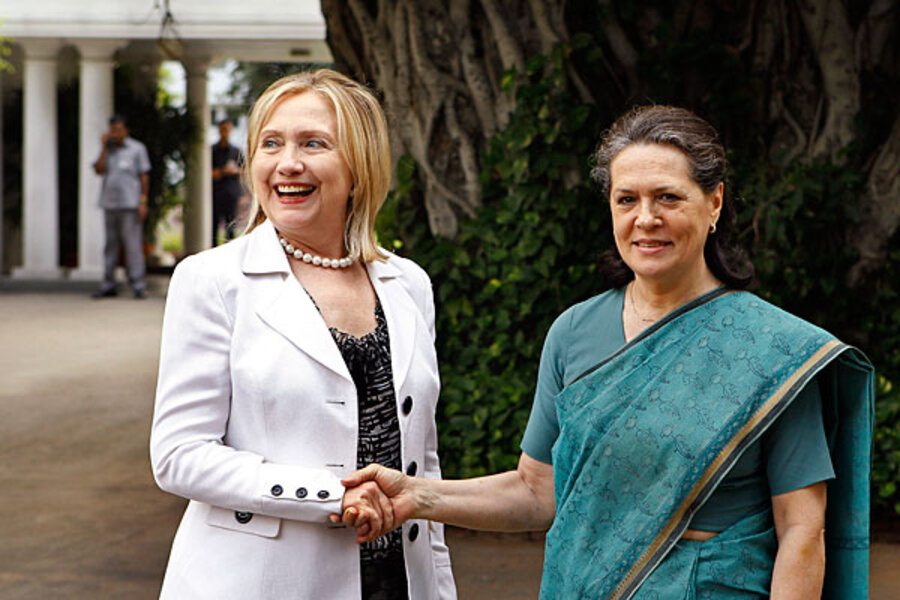During Hillary Clinton's India visit, nuclear power is front and center
Loading...
| New Delhi
A high-level US delegation led by Secretary of State Hillary Clinton is visiting India this week to hammer out details on a big list of joint efforts, pushing onward despite troubles with one deal that once was at the center of India-US ties.
Such a downpour of reports on different topics – ranging from counterterrorism to building e-governance software to training farmers in Africa – came during Ms. Clinton’s two-and-a-half hour meeting with Foreign Secretary S. M. Krishna that “it felt like we were in a monsoon,” she told reporters.
The US and India are making up for decades of estrangement by undertaking initiatives across many departments of the two governments. However, the landmark deal that started the new era of friendship – the civil nuclear deal of 2005 – has become a source of discord that has dampened some of the enthusiasm surrounding closer bilateral relations.
“The Americans have reasons to be peeved about how this worked out,” says Ashley Tellis, one of the US negotiators on the nuclear deal. “But the broader trend toward a deepening relationship will continue.”
Civil nuclear deal
Because of its off-limits status within nuclear industry after testing nuclear weapons in 1998, India could not turn to foreign companies to help expand its nuclear power sector in the face of massive energy needs. The deal with the US, struck in 2005, was meant to open India to foreign investment in its nuclear power sector.
The US had offered to ease international restrictions on nuclear trade with India in an effort to draw the two countries closer together and find a market for the US nuclear industry.
Prime Minister Manmohan Singh and then-President George W. Bush struck the deal, heralding a new era of US-India relations after decades of a cold war frost. However, the deal barely made it through India’s Parliament, which eventually insisted that foreign suppliers of nuclear technology share liability in the case of a nuclear mishap. US nuclear firms, in turn, have been unwilling to come to India under that liability law.
So India has looked to lure European vendors, instead.
Did the US go back on a deal?
Enter a recent meeting of the international Nuclear Suppliers Group.
The NSG passed a rule that bars nuclear technology transfer to countries like India that have not signed the Nuclear Nonproliferation Treaty. This meant that certain technology knowledge can't be transferred to India by the foreign countries that have it – including the US and Europe. But India specifically seeks technology transfer.
Some in India say the new rule proves that the US is going back on its part of the 2005 bargain to fight for India’s ability to access nuclear technology overseas – all in an effort to strong arm New Delhi to change its liability law.
“The NSG, as I see it, is being used by the Obama administration essentially as a tool to advance their reactor sales,” says Bharat Karnad, a nuclear expert at the Center for Policy Research in New Delhi and an early opponent of the nuclear deal.
Tellis disagrees with this, as does the US delegation. The Hindu newspaper reported that the US deputy secretary of energy told a group of students in New Delhi on Monday that “there is no betrayal of sorts.”
Clinton, who was also asked about the issue by reporters, said: “Nothing about the new … restrictions agreed to by the Nuclear Suppliers Group members should be construed as detracting from the unique impact and importance of the US-India civil nuclear agreement.”
Hurdles
But both Tellis and Mr. Karnad say India’s liability law remains a serious obstacle to the US-India nuclear deal actually delivering on its vision of US firms helping expand India's power sector, despite various workarounds being proposed by the Indian government. Both agree that Mr. Singh’s current government is too weak to get Parliament to change the law.
For some commentators, this impasse, along with the recent Indian decision to drop the two American firms from an ongoing competition to supply 126 new jet fighters, is raising some doubts about the seriousness of the relationship.
“Bluntly stated, some key policymakers in the United States are beginning to express private doubts about whether or not India really wants to pursue a viable strategic partnership,” writes regional expert Sumit Ganguly in the Asian Age newspaper.
Tellis points out the relationship has grown much larger than nuclear issues. And he’s not ready to give up on the deal anyway.
“We always knew this was not something that would be consummated in a matter of a year or even a matter of a decade,” says Tellis. “I think this is an act that is still playing itself out.”


